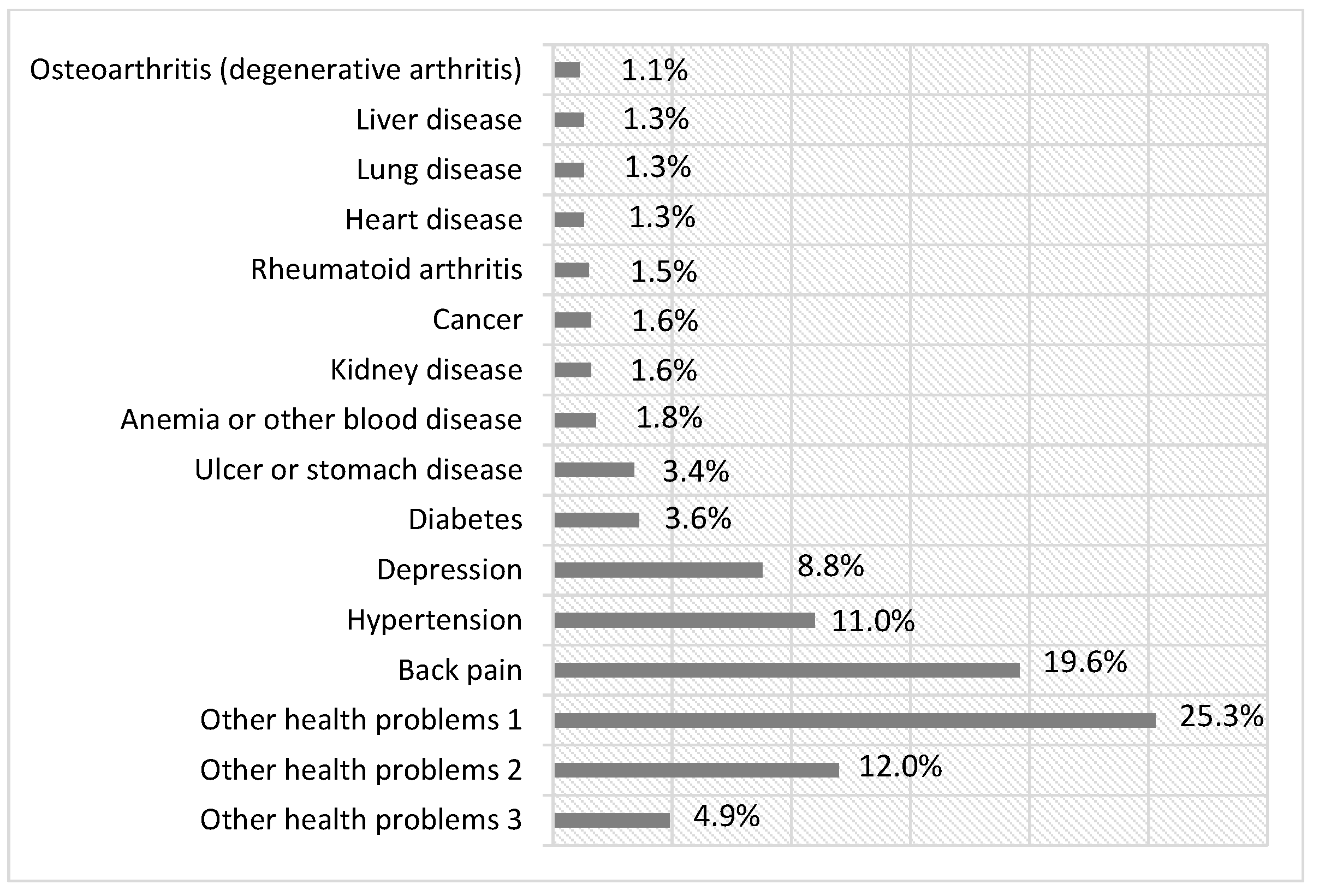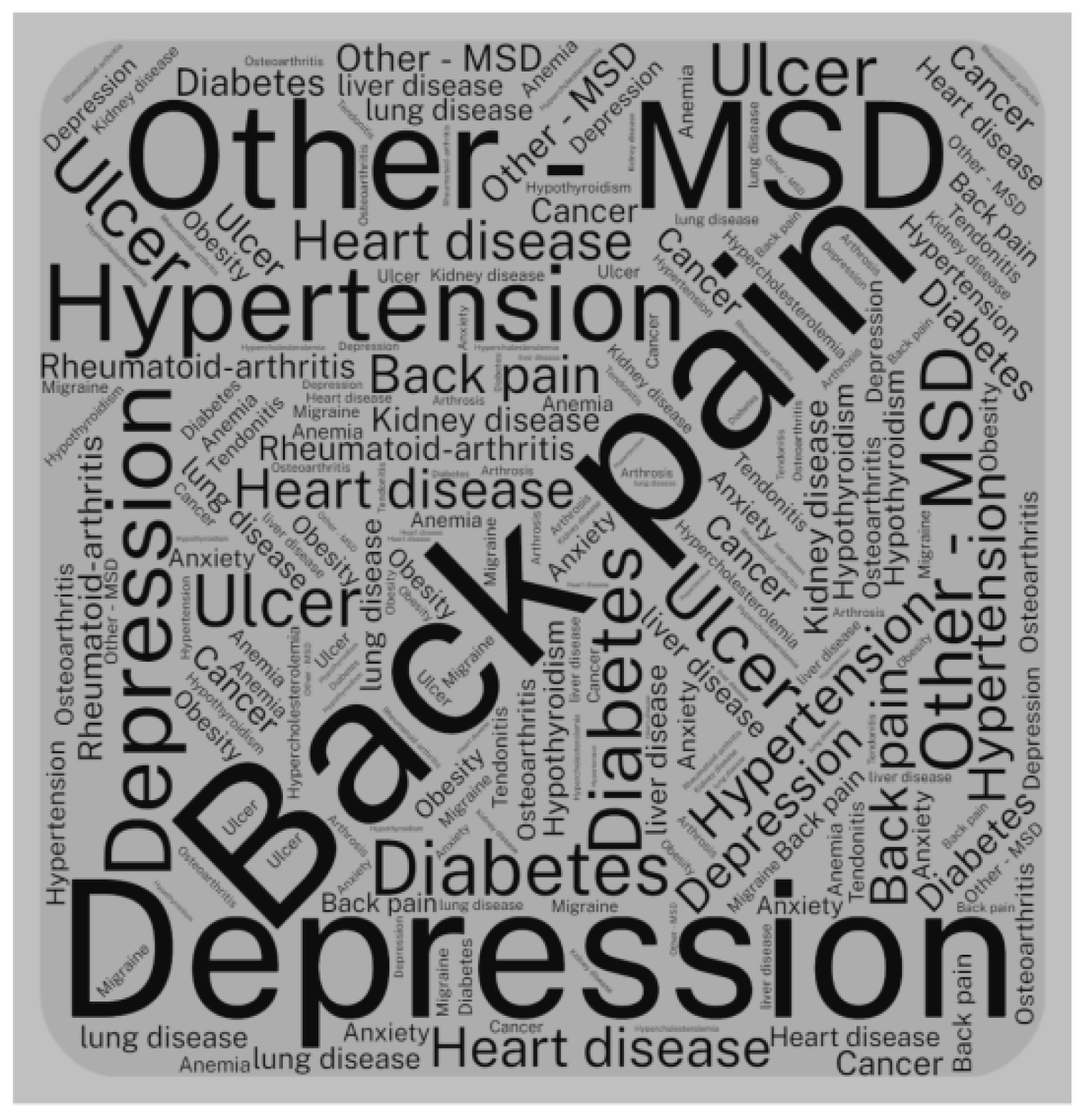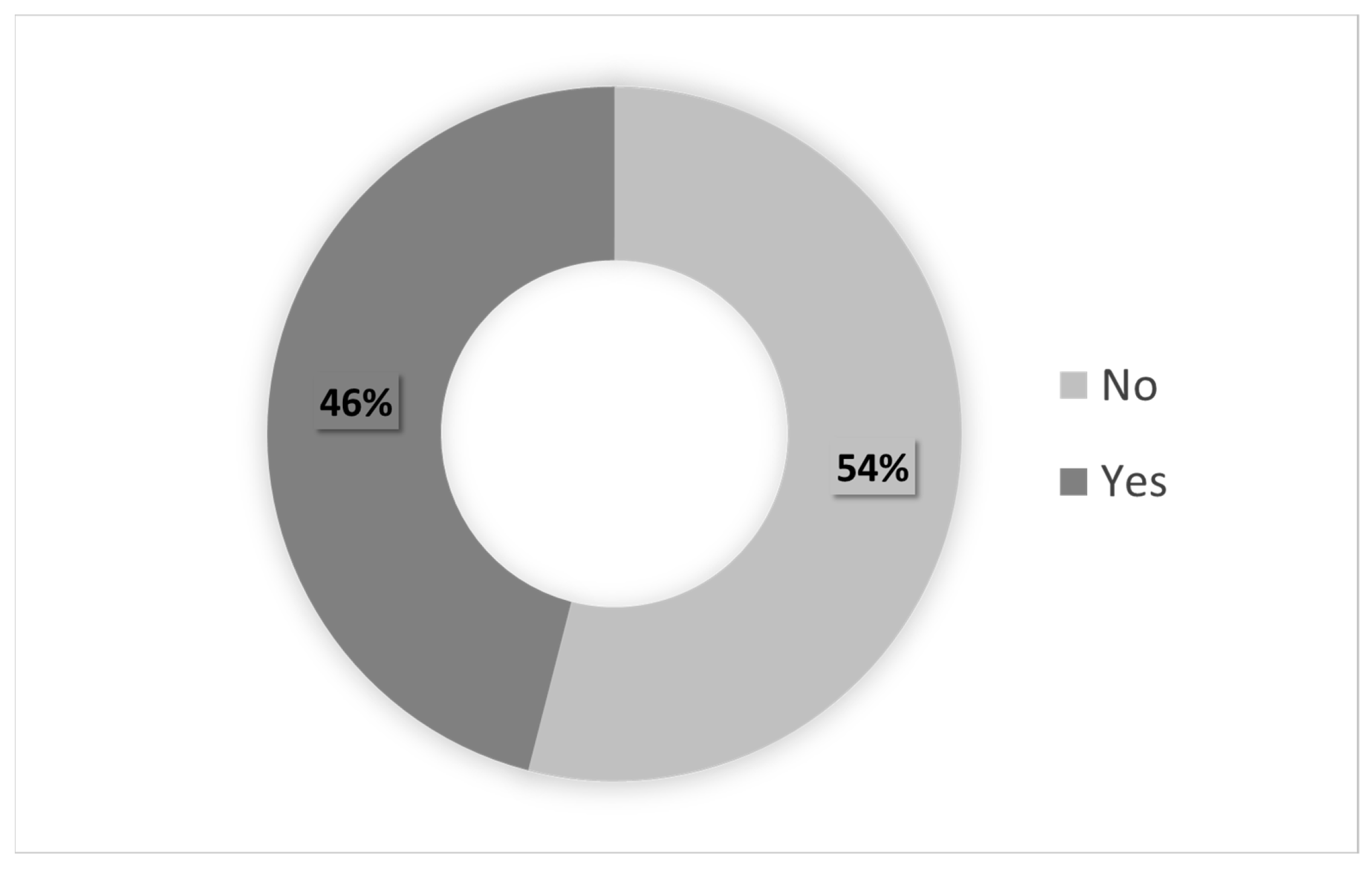Prevalence of Comorbidity and Its Effects on Sickness-Absenteeism among Brazilian Legislative Civil Servants
Abstract
1. Introduction
1.1. Work Absenteeism and Sickness Absenteeism
1.2. Comorbidity
2. Materials and Methods
2.1. Experimental Design
2.2. Participants
2.3. Measurements and Data Collection
2.4. Statistical Analysis
3. Results
3.1. Sociodemographic and Occupation Characteristics
3.2. Global Sickness Absenteeism Data
3.3. Individual Health Condition (Comorbidities)
3.4. Correlation between Comorbidity Index (CI), Working Days Lost, and Sociodemographic Variables
4. Discussion
4.1. Sickness Absenteeism
4.2. Comorbidity
4.3. Comorbidity and Sickness Absenteeism
5. Conclusions
Author Contributions
Funding
Institutional Review Board Statement
Informed Consent Statement
Data Availability Statement
Conflicts of Interest
References
- ILO (International Labour Organization). Safety and Health at Work. 2021. Available online: https://www.ilo.org/global/topics/safety-and-health-at-work/lang--en/index.htm (accessed on 6 August 2021).
- European Health Information Gateway. Absenteeism from Work Due to Illness, Days per Employee per Year. 2021. Available online: https://gateway.euro.who.int/en/indicators/hfa_411-2700-absenteeism-from-work-due-to-illness-days-per-employee-per-year/ (accessed on 6 August 2021).
- BRASIL, Secretaria da Previdência. Dados Estatísticos—Saúde e Segurança do Trabalhador. 2019. Available online: https://www.gov.br/previdencia/pt-br/assuntos/previdencia-social/saude-e-seguranca-do-trabalhador/dados-de-acidentes-do-trabalho (accessed on 7 July 2021).
- Leão, A.L.D.M.; Barbosa-Branco, A.; Neto, E.R.; Ribeiro, C.A.N.; Turchi, M.D. Absenteísmo-doença no serviço público municipal de Goiânia. Rev. Bras. de Epidemiol. 2015, 18, 262–277. [Google Scholar] [CrossRef] [PubMed]
- Rodrigues, C.D.S.; De Freitas, R.M.; Assunção, A.; Bassi, I.B.; De Medeiros, A.M. Absenteísmo-doença segundo autorrelato de servidores públicos municipais em Belo Horizonte. Rev. Bras. De Estud. De Popul. 2013, 30, 135–154. [Google Scholar] [CrossRef]
- Daniel, E.; Koerich CR, C.; Lang, A. The absenteeism profile among municipal public servants of the city of Curitiba, from 2010 to 2015|O perfil do absenteísmo dos servidores da prefeitura municipal de Curitiba, de 2010 a 2015. Rev. Bras. Med. do Trab. 2017, 15, 142–149. [Google Scholar] [CrossRef]
- McGrandle, J.; Ohemeng, F.L.K. The conundrum of absenteeism in the Canadian public service: A wicked problem perspective. Can. Public Adm. 2017, 60, 215–240. [Google Scholar] [CrossRef]
- Deady, M.; Collins, D.A.J.; A Johnston, D.; Glozier, N.; A Calvo, R.; Christensen, H.; Harvey, S.B. The impact of depression, anxiety and comorbidity on occupational outcomes. Occup. Med. 2021, 72, 17–24. [Google Scholar] [CrossRef] [PubMed]
- Sampaio, E.; Baptista, J.S. Absenteeism of Public Workers—Short Review. In Occupational and Environmental Safety and Health; Springer International Publishing: Cham, Switzerland, 2019; pp. 345–353. [Google Scholar] [CrossRef]
- de Oliveira, P.L. Impacto das Características e Condições de Trabalho no Absentismo em Assistentes Operacionais de Escolas e Jardins de Infância; Universidade Fernando Pessoa: Porto, Portugal, 2016. [Google Scholar]
- Santi, D.B.; Barbieri, A.R.; Cheade, M.D.F.M. Absenteísmo-doença no serviço público brasileiro: Uma revisão integrativa da literatura. Rev. Bras. De Med. Do Trab. 2018, 16, 71–81. [Google Scholar] [CrossRef]
- Valderas, J.M.; Starfield, B.; Sibbald, B.; Salisbury, C.; Roland, M. Defining Comorbidity: Implications for Understanding Health and Health Services. Ann. Fam. Med. 2009, 7, 357–363. [Google Scholar] [CrossRef] [PubMed]
- Broeiro, P. Multimorbilidade e comorbilidade: Duas perspectivas da mesma realidade. Rev. Port. De Med. Geral E Fam. 2015, 31, 150–160. [Google Scholar] [CrossRef]
- Harrison, C.; Fortin, M.; Akker, M.V.D.; Mair, F.; Calderon-Larranaga, A.; Boland, F.; Wallace, E.; Jani, B.; Smith, S. Comorbidity versus multimorbidity: Why it matters. J. Multimorb. Comorbidity 2021, 11, 263355652199399. [Google Scholar] [CrossRef] [PubMed]
- Sangha, O.; Stucki, P.D.m.G.; Liang, M.; Fossel, A.; Katz, J. The Self-Administered Comorbidity Questionnaire: A new method to assess comorbidity for clinical and health services research. Arthritis Rheum. 2003, 49, 156–163. [Google Scholar] [CrossRef] [PubMed]
- Instituto Brasileiro de Geografia e Estatistica. Pesquisa Nacional de Saúde; Rio de Janeiro. 2019. Available online: https://teca.ibge.gov.br/visualizacao/livros/liv91110.pdf (accessed on 6 August 2021).
- Sundstrup, E.; Jakobsen, M.D.; Mortensen, O.S.; Andersen, L.L. Joint association of multimorbidity and work ability with risk of long-term sickness absence: A prospective cohort study with register follow-up. Scand. J. Work Environ. Health 2017, 43, 146–154. [Google Scholar] [CrossRef] [PubMed]
- Serranheira, F.; Sousa-Uva, M.; Heranz, F.; Kovacs, F. Low Back Pain (LBP), work and absenteeism. Work 2020, 65, 463–469. [Google Scholar] [CrossRef] [PubMed]
- Aladeneyi, I.; Adeneyi, O.V.; Owolabi, E.O.; Fawole, O.; Adeolu, M.; Goon, D.T.; Ajayi, A.I. Prevalence, awareness and correlates of hypertension among urban public workers in Ondo State, Nigeria. Online J. Health Allied Sci. 2017, 16, 1. [Google Scholar]
- Dias, A.; Gómez-Salgado, J.; Bernardes, J.M.; Ruiz-Frutos, C. Factors affecting sick leave duration for non-work-related temporary disabilities in brazilian university public servants. Int. J. Environ. Res. Public Health 2018, 15, 2127. [Google Scholar] [CrossRef] [PubMed]
- Fouad, A.M.; Waheed, A.; Gamal, A.; Amer, S.; Abdellah, R.F.; Shebl, F.M. Effect of Chronic Diseases on Work Productivity: A Propensity Score Analysis. J. Occup. Environ. Med. 2017, 59, 480–485. [Google Scholar] [CrossRef] [PubMed]
- Hendriks, S.M.; Spijker, J.; Licht, C.M.; Hardeveld, F.; de Graaf, R.; Batelaan, N.M.; Penninx, B.W.; Beekman, A.T. Long-term work disability and absenteeism in anxiety and depressive disorders. J. Affect. Disord. 2015, 178, 121–130. [Google Scholar] [CrossRef] [PubMed]
- Troelstra, S.A.; Straker, L.M.; Harris, M.; Brown, S.; van der Beek, A.J.; Coenen, P. Multimorbidity is common among young workers and related to increased work absenteeism and presenteeism: Results from the population-based raine study cohort. Scand. J. Work. Environ. Health 2020, 46, 218–227. [Google Scholar] [CrossRef] [PubMed]





| Variables | ALEGO | House of Deputies | Federal Senate | All LH | |
|---|---|---|---|---|---|
| n (%) | n (%) | n (%) | n (%) | ||
| Gender | Male | 11 (61.1) | 117 (48.4) | 104 (57.8) | 232 (52.7) |
| Female | 7 (38.9) | 125 (51.6) | 76 (42.2) | 208 (47.3) | |
| Marital status | Single/widowed | 2 (11.1) | 37 (15.3) | 53 (29.5) | 92 (20.9) |
| Married/stable union | 12 (66.7) | 187 (77.3) | 105 (58.3) | 304 (69.1) | |
| Separated | 4 (22.2) | 18 (7.4) | 22 (12.2) | 44 (10.0) | |
| Education | Elementary school | 1 (5.6) | 0 (0.0) | 1 (0.6) | 2 (0.4) |
| High school | 2 (11.1) | 6 (2.5) | 4 (2.2) | 12 (2.7) | |
| College | 7 (38.9) | 29 (12.0) | 33 (18.3) | 69 (15.7) | |
| Specialization | 6 (33.3) | 141 (58.3) | 110 (61.1) | 257 (58.4) | |
| Master | 2 (11.1) | 44 (18.2) | 26 (14.5) | 72 (16.4) | |
| PhD | 0 (0.0) | 22 (9.0) | 6 (3.3) | 28 (6.4) | |
| Age | M(SD) 1 | 43.1 (10.0) | 46.6 (7.6) | 45.5 (9.1) | 46.3 (9.4) |
| Working hours | M(SD) 1 | 6.4 (0.6) | 8 (0.0) | 7.6 (0.6) | 7.8 (0.5) |
| Length of service (Seniority) | M(SD) 1 | 12.4 (12.4) | 14.5 (8.3) | 14.2 (9.7) | 15.8 (10.5) |
| All Houses | Absences (Days) | Percentage (%) | Number of Absent Servants | Percentage (%) | Mean (d/s/yr) |
|---|---|---|---|---|---|
| ALEGO | 4272 | 2.9 | 107 | 2.6 | 9.98 |
| House of Deputies | 103,981 | 71.8 | 2567 | 61.9 | 10.13 |
| Federal Senate | 36,649 | 25.3 | 1475 | 35.6 | 6.21 |
| Total | 144,902 | 100 | 4149 | 100 | 8.73 |
| CI | Frequency | Percentage (%) | Cumulative Percentage (%) |
|---|---|---|---|
| 0.00 | 154 | 34.5 | 34.5 |
| 0.02 | 29 | 6.5 | 40.9 |
| 0.04 | 77 | 17.2 | 58.2 |
| 0.06 | 41 | 9.2 | 67.3 |
| 0.08 | 33 | 7.4 | 74.7 |
| 0.10 | 16 | 3.6 | 78.3 |
| 0.13 | 30 | 6.7 | 85.0 |
| 0.15 | 18 | 4.0 | 89.0 |
| 0.17 | 11 | 2.5 | 91.5 |
| 0.19 | 12 | 2.7 | 94.2 |
| 0.21 | 6 | 1.3 | 95.5 |
| 0.23 | 2 | 0.4 | 96.0 |
| 0.25 | 8 | 1.8 | 97.8 |
| 0.27 | 2 | 0.4 | 98.2 |
| 0.29 | 1 | 0.2 | 98.4 |
| 0.31 | 3 | 0.7 | 99.1 |
| 0.33 | 2 | 0.4 | 99.6 |
| 0.35 | 1 | 0.2 | 99.8 |
| 0.44 | 1 | 0.2 | 100.0 |
| Total | 447 | 100.0 |
| Number of Diseases or Health Problems | Individuals | Percentage | Cumulative Percentage |
|---|---|---|---|
| 0 | 154 | 34.5 | 34.5 |
| 1 | 130 | 29.1 | 63.5 |
| 2 | 65 | 14.5 | 78.1 |
| 3 | 52 | 11.6 | 89.7 |
| 4 | 33 | 7.4 | 97.1 |
| 5 | 7 | 1.6 | 98.7 |
| 6 | 4 | 0.9 | 99.6 |
| 7 | 1 | 0.2 | 99.8 |
| 9 | 1 | 0.2 | 100.0 |
| Total | 447 | 100.0 |
| Correlation | ||||||
|---|---|---|---|---|---|---|
| Variables | CI | Age | Seniority | Working Hours | Number of Working Days Lost | |
| Age | (r) | 0.116 * | 1 | - | - | - |
| N | 447 | 4149 | - | - | - | |
| Seniority | (r) | 0.133 ** | 0.762 ** | 1 | - | - |
| N | 447 | 4149 | 4149 | - | - | |
| Working hours | (r) | −0.046 | −0.053 ** | −0.045 ** | 1 | - |
| N | 447 | 4149 | 4149 | 4149 | - | |
| Number of working days lost | (r) | 0.254 ** | 0.107 ** | 0.117 ** | 0.032 * | 1 |
| N | 447 | 4149 | 4149 | 4149 | 4149 | |
Disclaimer/Publisher’s Note: The statements, opinions and data contained in all publications are solely those of the individual author(s) and contributor(s) and not of MDPI and/or the editor(s). MDPI and/or the editor(s) disclaim responsibility for any injury to people or property resulting from any ideas, methods, instructions or products referred to in the content. |
© 2023 by the authors. Licensee MDPI, Basel, Switzerland. This article is an open access article distributed under the terms and conditions of the Creative Commons Attribution (CC BY) license (https://creativecommons.org/licenses/by/4.0/).
Share and Cite
Sampaio, F.E.; Oliveira, M.J.S.; Areosa, J.; Facas, E. Prevalence of Comorbidity and Its Effects on Sickness-Absenteeism among Brazilian Legislative Civil Servants. Int. J. Environ. Res. Public Health 2023, 20, 5036. https://doi.org/10.3390/ijerph20065036
Sampaio FE, Oliveira MJS, Areosa J, Facas E. Prevalence of Comorbidity and Its Effects on Sickness-Absenteeism among Brazilian Legislative Civil Servants. International Journal of Environmental Research and Public Health. 2023; 20(6):5036. https://doi.org/10.3390/ijerph20065036
Chicago/Turabian StyleSampaio, Francisco Edison, Manuel Joaquim Silva Oliveira, João Areosa, and Emílio Facas. 2023. "Prevalence of Comorbidity and Its Effects on Sickness-Absenteeism among Brazilian Legislative Civil Servants" International Journal of Environmental Research and Public Health 20, no. 6: 5036. https://doi.org/10.3390/ijerph20065036
APA StyleSampaio, F. E., Oliveira, M. J. S., Areosa, J., & Facas, E. (2023). Prevalence of Comorbidity and Its Effects on Sickness-Absenteeism among Brazilian Legislative Civil Servants. International Journal of Environmental Research and Public Health, 20(6), 5036. https://doi.org/10.3390/ijerph20065036







